What are product attributes and benefits? Believe it or not, they are the source of academic research and studies...
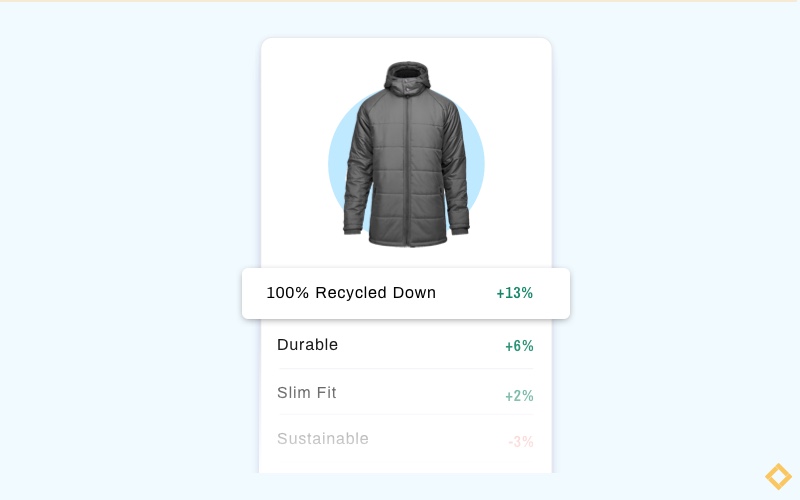
What are product attributes and benefits? Believe it or not, they are the source of academic research and studies...
Which of these statements do you agree with?
I sell and promote my products:
A. Based on their features.
B. Based on how they contribute to my customers’ lives.
If you agree with statement A, then you are selling product attributes. If you agree with statement B, then you are selling product benefits.
But while these definitions may seem straightforward, there’s much more to product attributes and benefits than meets the eye.
I propose a third statement:
C. I sell and promote my products’ features based on how they benefit the lives of my customers.
I probably don’t have to tell you how statement C is something every retailer strives towards.
But to keep things easy, this article will explore the definitions of product attributes and benefits so that you can get it right once and for all.
I’ll also show you why statement C is the future of retail marketing.
Here’s what this article will cover:
Let’s jump straight in.
Product attributes are the components of a product that describe its features. Product attributes are concrete, objective, and can be observed.
The attributes of a product don’t change. But which attributes you choose to show will vary depending on the campaign, customer, or brand.
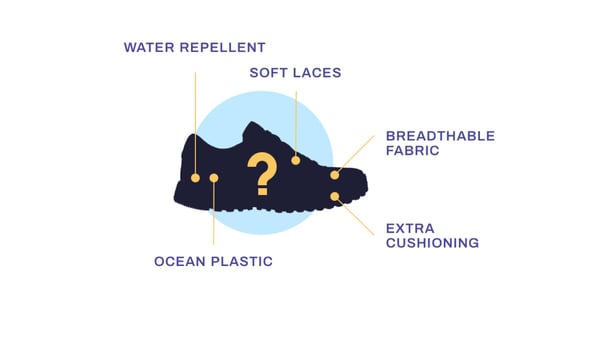
E.g., the product attributes of a shoe are the special components that the shoe is made from.
Product benefits, on the other hand, are the features that are most important to the customer. More often than not these are conceptual and change according to the individual shopper or customer segment.
For the example above, this would be:
You get the idea.
Let’s take a look at an example of an eCommerce store that differentiates between attributes and benefits.
Samsung is selling earbuds that are “wireless”, “black”, and have a “charging case”. These are product attributes. On the PDP for those earbuds, they actually separate the attributes from the benefits.
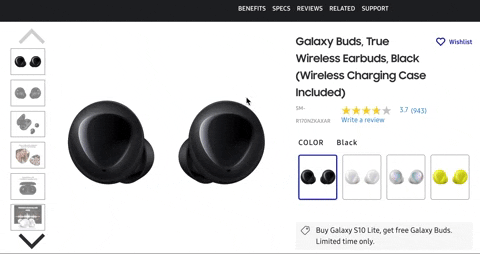
According to Wu, Day, and MacKay (1988), distinguishing between attributes and benefits, offers opportunities to study consumer preferences. Separating attributes from benefits on your webshop will help you understand which sections drive purchase behavior.
So Samsung has a separate “benefits” section. And when you click on it, you’re directed down the PDP to a product description that highlights how the consumer can listen to “the music [they] love” whilst “walking, working or working out”.
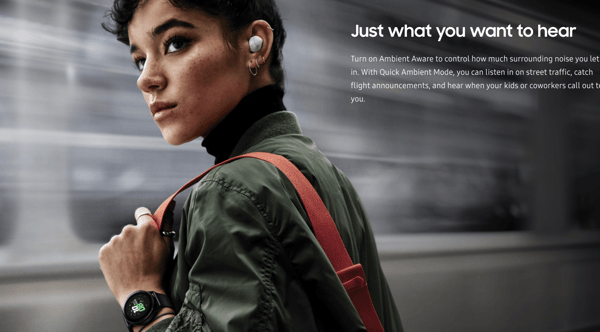
Click on the section “benefits” or keep scrolling down the PDP and you see many benefits that different product features can provide, depending on the shoppers' needs.
Samsung chooses to differentiate between the two as a good way to get to the bottom of their customer’s preferences and shopping choices.
What about marketing campaigns?
Well, for campaigns and ads, Hernandez, Wright, and Rodrigues (2014) also differentiate between “benefit-appeal” copy (e.g., values, abstraction, and ends) and “attribute-appeal” copy (e.g., details, concreteness, and means).
A famous example that the paper references is the 2002 Burger King ad copy that changed from “now you can pay rent and eat” - emphasizing a benefit - to “items starting at $1”, which emphasized an attribute.
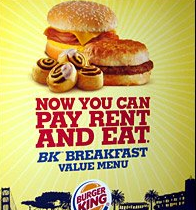 Burger King ad from 2002 emphasizes the benefit of “paying rent”.
Burger King ad from 2002 emphasizes the benefit of “paying rent”.
The paper found that benefit vs. attribute appeals will resonate for consumers depending on their construal levels...but that’s a big theory for another article.
To sum up -
The point Hernandez, Wright, and Rodriguez make is a good way to differentiate between product attributes and benefits:
However, in the end, both attribute-appeal copy and benefit-appeal copy serve to reinforce Burger King’s value proposition that their meals are affordable.
For Samsung, their benefits and attributes also serve a common goal: to provide as much tailored product information to their target shopper as possible.
So while there is value in differentiating between product attributes and benefits, in most cases attributes and benefits go hand-in-hand - which we’ll see examples of later on.
Hernandez, Wright, and Rodriguez thus define product attributes and benefits in line with Gutman’s means-end chain concept.
Why is all this important, you ask?
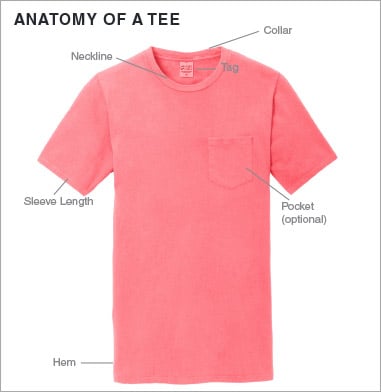
Product attributes of a simple t-shirt. So what’s special about it? That’s where your product benefits come in.
I could list many reasons for the importance of product attributes and benefits when it comes to understanding consumer choice, preference, and behavior.
But to give you a better overview, I’ve grouped their importance into two categories:
1. Psychological
2. Technical
By psychological I mean understanding consumer psychology. Product attributes and benefits are important because they optimize your customer-centric approach by using theory and research.
And by technical I mean all the ins and outs of your eCommerce offering that product attributes and benefits will help you optimize.
Let’s take a closer look.
Gutman’s means-end chain (1982) is a way to understand why consumers choose the products they do for better product positioning.
The means-end chain model starts with the physical nature of the product (attributes) and then works its way up to understand what the product delivers to the consumer (benefits).
The last phase of the chain asks: What does the product help the consumer achieve (values)?
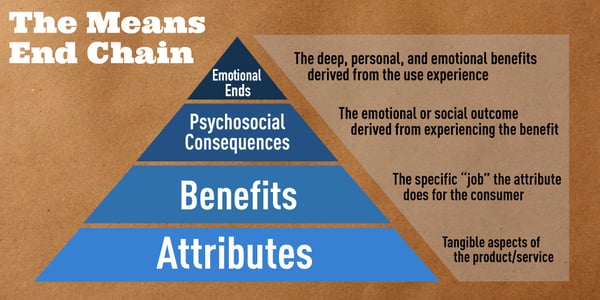 Gutman’s means-end chain from “linking values to products” study by Raffaele and Simona, 2002.
Gutman’s means-end chain from “linking values to products” study by Raffaele and Simona, 2002.
It basically suggests that every purchase is a means to an end.
For example, say I want to buy sunglasses. I choose the ones with polarized lenses, which is a product attribute.

Polarized lenses for the beach, safari, skiing, or lounging on my terrace? So what added value does the polarized lens bring to my life?
Why? Because I want to go skiing and the sun is more intense in the mountains.
What’s the value of the polarized lenses in this context? I want to protect my eyes which means,
a) I value my health,
b) I can afford quality attributes if they support this value.
This works for utilitarian products, too, since every choice or product attribute (be it price, material, or even color) has a wider meaning behind it.
Understanding what product attributes resonate with your consumers and why is important for a myriad of things like;
In this context, product attributes and benefits are important to understanding your customers by linking behavior to psychology.
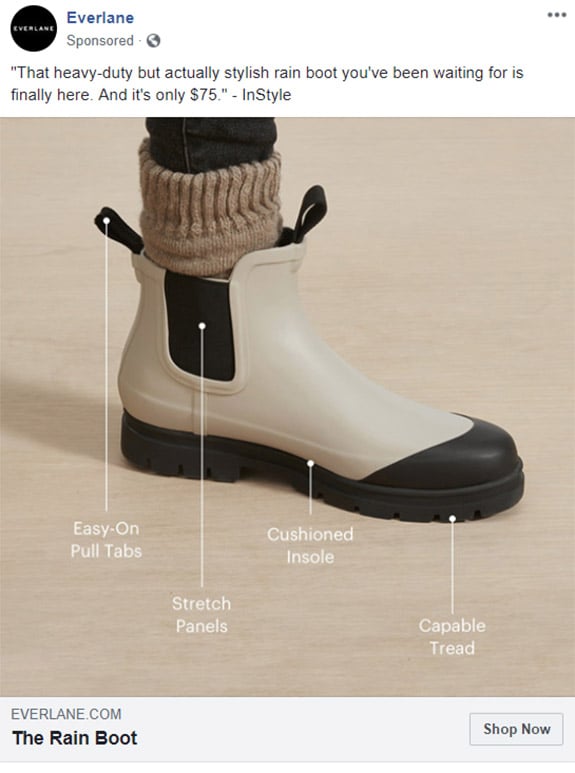
Everlane’s Facebook ad for “The Rain Boot” shows carefully curated product attributes in line with their comfort/ease campaign.
Next to this, showing the attributes and benefits of your products (as product badges or in your product descriptions, for instance) are nudges that do three important things:
Hold on a second - what are nudges again?
Nudges (which we’ve written extensively about - so I'm glad you asked), are subtle changes to the choice architecture. For eCommerce, this choice architecture is basically how you choose to present your products on-site - download our free ebook at the end of this article for more!
Nudges aim to provide as much information to the customer without inflicting choice overload.
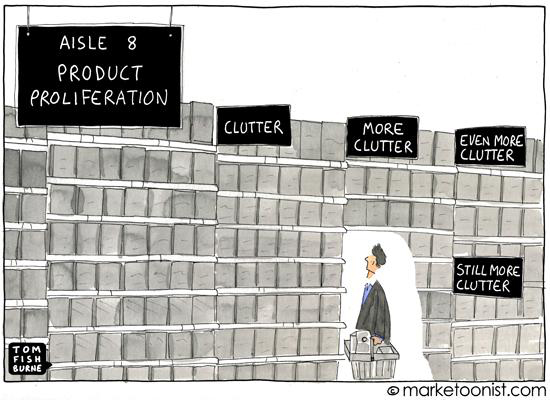
Presented in the right way at the right time and product attributes and benefits will be nudges that help your shoppers make better decisions, optimizing the overall customer journey on your webshop!
67% of American shoppers want to know everything that goes into their food. 46% are swayed by labels like “organic” or “non-GMO”.

Lush have these labels on their webshop footer to give their customers reasons to shop with their brand.
Having a deeper understanding of which product attributes appeal to your target audience as benefits will help you sway your customers to make informed decisions as they shop. This is important psychologically, but also for product taxonomy.
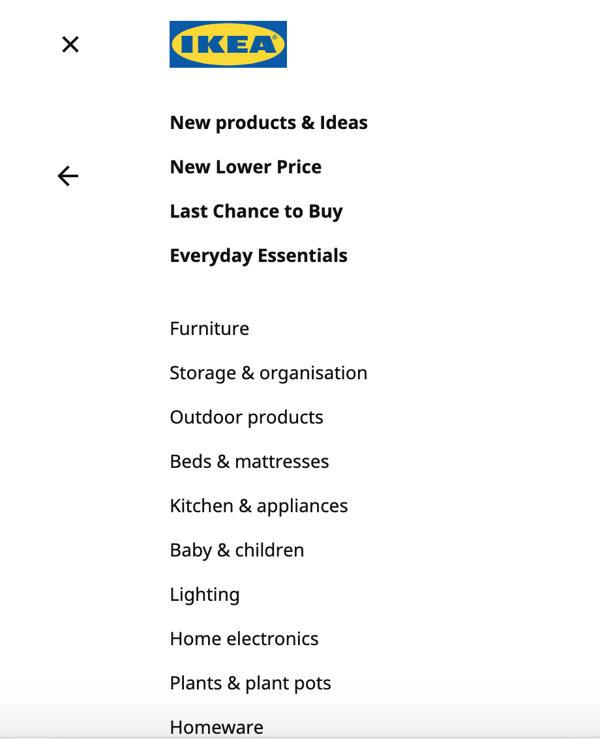
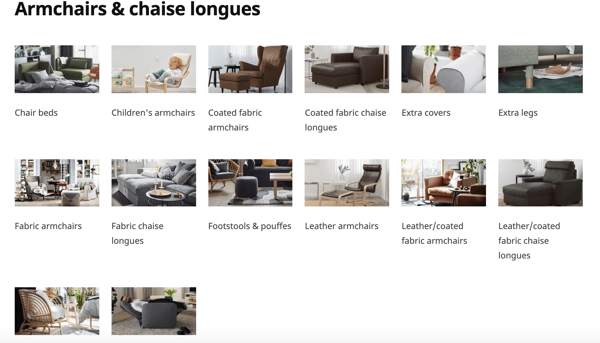
IKEA’s product taxonomy relies on product attributes to guide the shopper’s attention.
Your product attributes will help you organize your products in a way that makes the most sense to your customers.

Google suggestions will show popular keywords you can use to optimize your product taxonomy.
Alongside product taxonomy, product attributes and benefits are important to help with search bar optimization.
In other words:
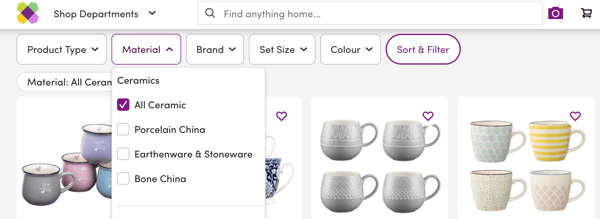
Wayfair’s product taxonomy can be filtered by material: note how ceramic, porcelain, and stoneware are top materials after doing keyword research and optimizing accordingly (see previous image).
Product attributes and benefits are keywords your customers are using to interact with your brand. Once you understand which keywords rank the highest, you can optimize your entire eCommerce organization and communication.
Now that we know why this stuff is important, let’s take a small step back. We’ve already talked about how product attributes and benefits are interlinked.
But as a marketer, you want to find the benefits from your product attributes.
How do you do this?
Let’s go back to our good friend Gutman. The means-end chain analyzes behavior in line with values. This means that first, you have to ask your customers why they choose or like the products they do using focus groups, interviews, or surveys in order to link behavior (attribute choices) to value (benefit choices).
More ways to get customer feedback include:
And a whole lot more...
Greats
Take a look at Greats’ review and rating box:
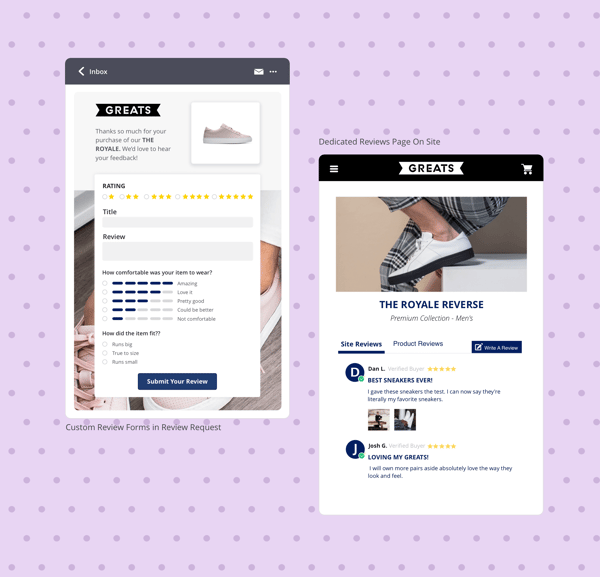 Source: Yotpo
Source: Yotpo
The questions are directed to how the sneakers’ attributes (size, comfort, color) benefit the shopper. Using the survey answers Greats can automate a customer review shown on their “product review” page.
So how do you find the benefits of your attributes? You enter into a dialogue with your customers. This is customer-centric retailing 101.
Ray-Ban
Next to this, you have to dissect and analyze your products. If you’re selling a pair of sunglasses, its attributes are its colors, size, fit, frame, and any special characteristics like polarized lenses that differentiate it from others:
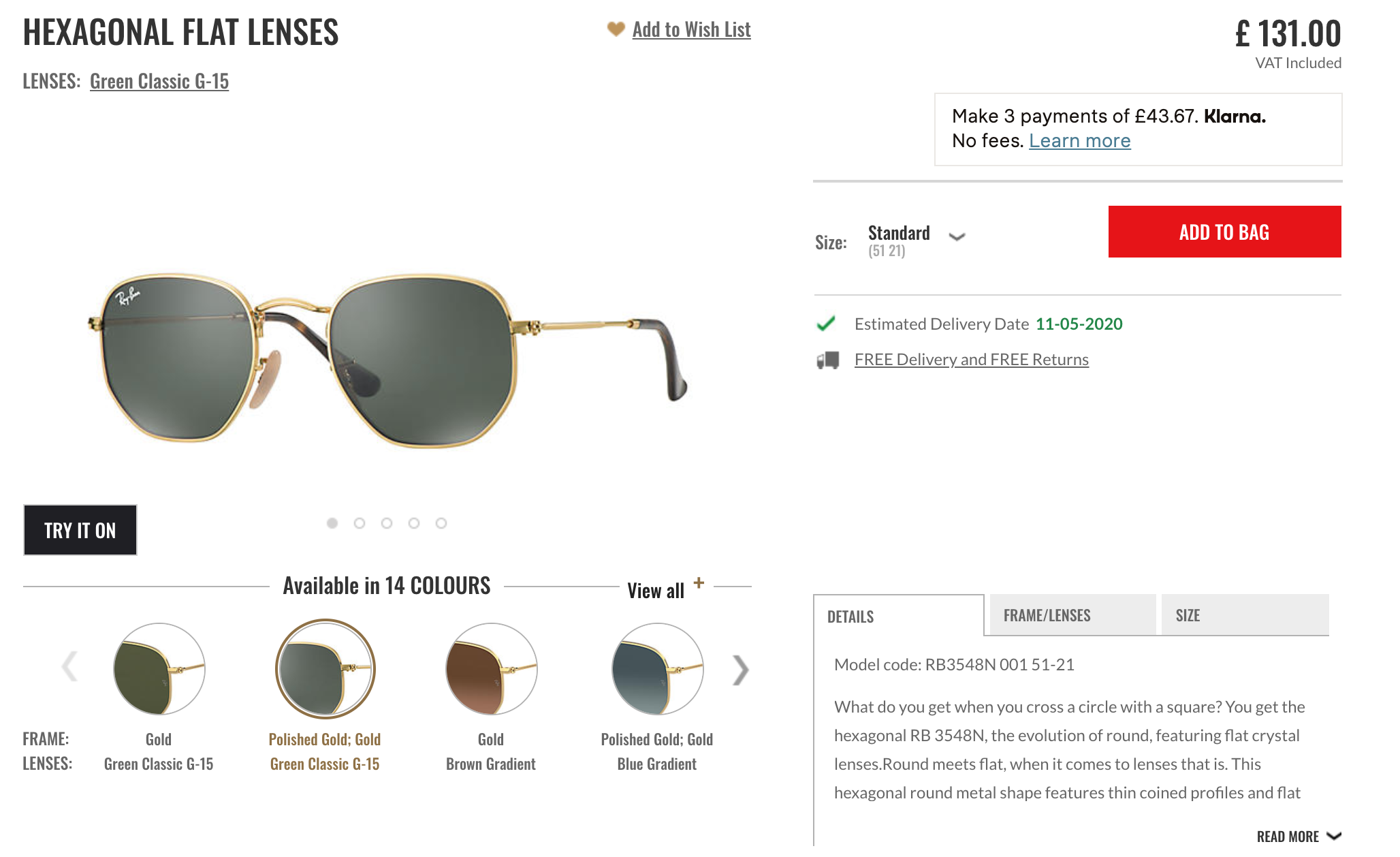
On Ray-Ban’s PDP, they have the details of the sunglasses which are the product’s features. Even the name of the product is its special attribute.
After all, you want to push your products as unique in the market, and this starts with identifying and presenting the sunglasses’ disruptive qualities.
So how does Ray-Ban identify what attributes are benefits?
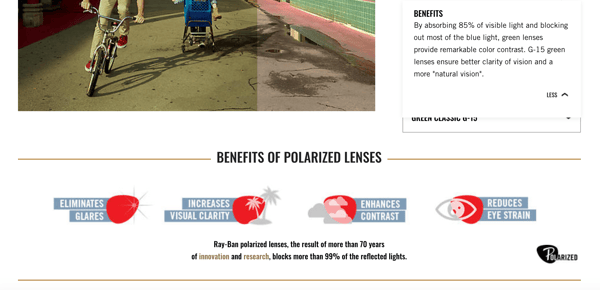
Different from Greats, Ray-Ban takes a product-centric approach. Since they promote their products as unique (the tagline “Never Hide” has dominated their ads since 2007) the benefits of their product attributes are founded in “more than 70 years of innovation and research”.
They take a scientific approach to analyzing benefits in terms of what sets their product apart from other sunglasses brands, in line with their unique brand positioning.
 In this Never Hide Ad, Ray-Ban links the “transparent” attribute of their Wayfarers, with being transparent as a person 👏 Gutman would be proud .
In this Never Hide Ad, Ray-Ban links the “transparent” attribute of their Wayfarers, with being transparent as a person 👏 Gutman would be proud .
Brands who have an expensive price-point (e.g., luxury, electronics, jewelry) will have a similar product promotion strategy. Premium brands should justify their product quality.
Top Shop
Top Shop, on the other hand, optimizes their product taxonomy by “category” (attributes) and “collection”, the latter which are product benefits like “Going Out Shoes” and “Vegan Shoes”.
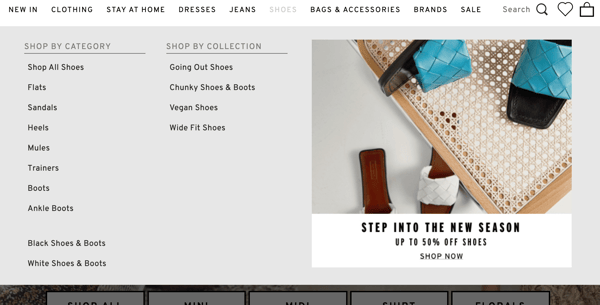
Sometimes, finding product benefits change by season. In order to truly understand what attributes are seen as benefits, therefore, you should be tracking trends.
Top Shop has collections that match their target audience’s desires and group similar product attributes together by their overarching benefits.
For example, flats and heels are great going out shoes in the summer, but in the winter you’d rather go out in boots or ankle boots, right?
The bottom line?
There are a plethora of examples of retailers finding benefits from attributes and presenting them accordingly. But these three examples sum it up quite nicely.
In order to find the benefits of your product attributes:
In the end, what you’ll achieve by bringing these strategies together are product-driven customer experiences both on-site and off.
This is how you bring the worlds of product-centricity (attributes) together with customer-centricity (benefits).
It’s about using Gutman’s means-end-chain to discover the why behind the buy for different customer segments. Once you acknowledge how most products are bought with a personal value in mind, then you can really get to the core of who is buying your products in the first place.
This brings product attributes together with product benefits. Let’s take a look at some examples.
Amazon
Amazon, perhaps the most dominant eCommerce store at the moment, has product descriptions that highlight both product attributes and benefits:
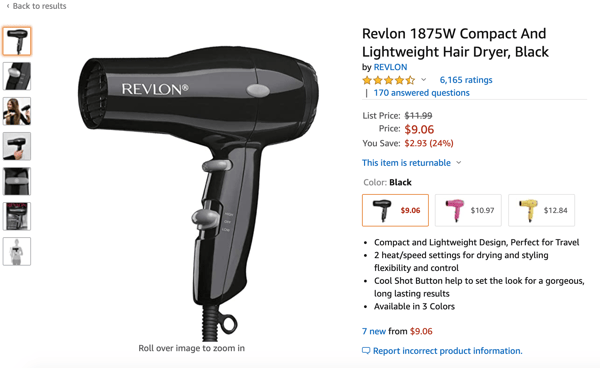
Each product attribute is followed by a product benefit: compact and lightweight (attribute), perfect for travel (benefit), etc.
Everlane
Moreover, Everlane - often praised for their great product descriptions - has a similar approach:
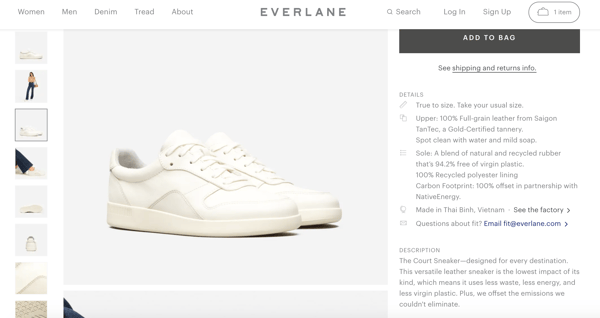
Their shoe is a sneaker (attribute) designed for every destination (benefit). The versatile leather (attribute) uses less waste (benefit). What you have is a shoe tailored to a specific customer - the eco-friendly shopper.
The sneakers’ attributes are presented in a way that will benefit Everlane’s target customer, whilst showing reasons for shopping with their brand over others.
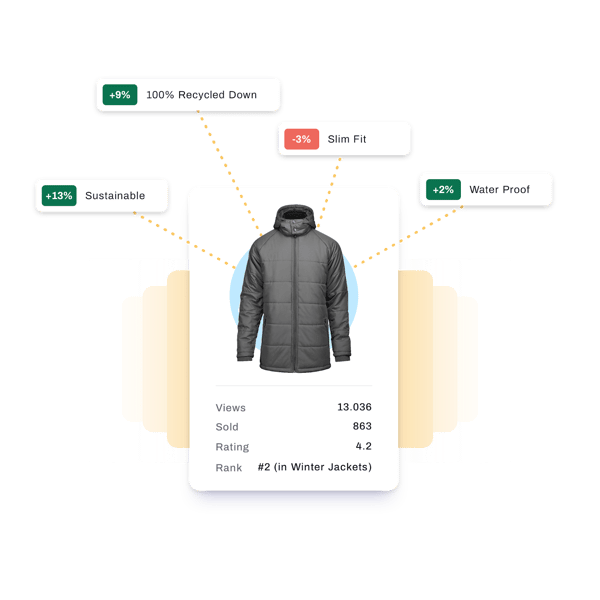
Bringing the worlds of product-centricity and customer-centricity together doesn’t stop at PDP optimization.
For example, you can test your attributes to learn which ones are the most important to your customers.
With that, you can drive purchase behavior from the PLP to PDP.
One way of doing this is by leveraging Dynamic Badges on the PLP. You can test which badges are most important at driving behavior.
Adidas
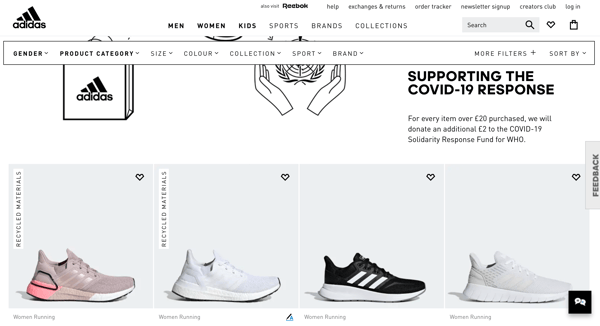
Let’s take the example of Adidas’ “Recycled Materials” badge. By testing this message, and different attributes like, “Extra Warm”, “Waterproof”, and “Durable” (for instance) Adidas could see which attributes their customers are most interested in.
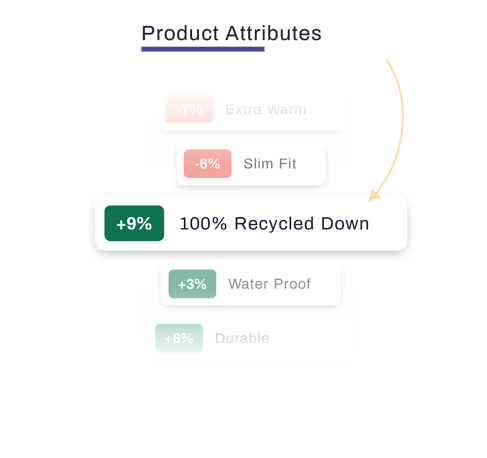
Let’s assume that they tested this and found that the attribute “recycled material” is their highest-performing message for this product. Adidas can promote this as a benefit in their omnichannel campaigns, re-targeting, email marketing, or even in-store.
In the end, this could look something like Adidas’ twitter campaign that highlights a product attribute (recycled material) to support a benefit (saving the ocean and conscious consumerism):
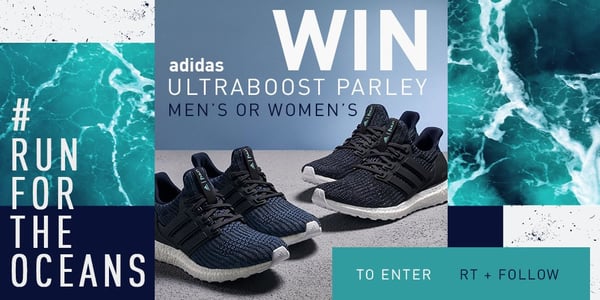
So it's by understanding which product attributes are important to who that you can begin to turn attributes into benefits.
Not only will you create more relevant, customer-centric campaigns, but you can test how these messages differ with seasons, trends, etc.
With this, you can create entire campaigns showing how this attribute is a benefit with value-driven copy!
Let’s break it down:
Bringing your product-centric and customer-centric approach together is the future of retail marketing. It’s about testing different messages and product features and then highlighting the features that resonate with specific customer segments.
Remember statement C?
C. I sell and promote my products' features based on how they benefit the lives of my customers.
When you look at the means-end chain model, this should be the crux of bringing product-centric and customer-centric together.
You learn what attributes your customers love about your products in order to foster a deeper understanding of those customers.
You're probably aware by now that product attributes and benefits have long been a source of academic research.
And product-centric vs. customer-centric approaches to marketing have always separated attributes from benefits. What I hope this article has shown you is that the two are actually interlinked.
For your product descriptions to provide the best kind of information, you should be showing attributes and benefits in line with your brand tone of voice.
For merchandising, test which product attributes and benefits drive purchase behavior on-site in order to optimize your product messages, taxonomy, and assortment.
And for your campaigns, finding which product attributes resonate as benefits using a means-end-chain approach will help you understand your customers on a deeper level.
Now it’s up to you!